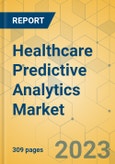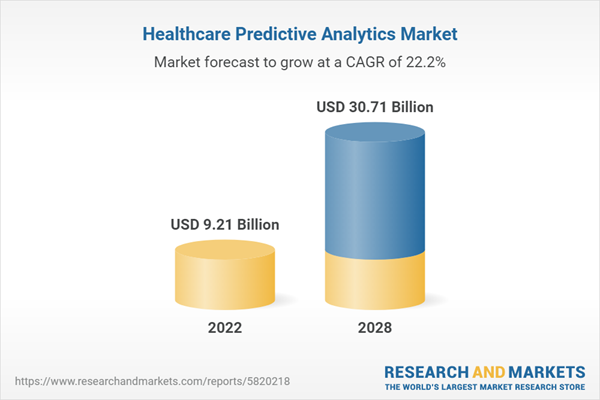Speak directly to the analyst to clarify any post sales queries you may have.
MARKET TRENDS & DRIVERS
Predictive AI Enhancing Patient Care and Health Outcomes
Predictive AI enhancing patient care and health outcomes is an emerging area of healthcare technology that uses artificial intelligence (AI) to help healthcare providers make informed decisions about a patient’s care. Predictive AI can analyze vast amounts of data from multiple sources to provide insights about the patient’s condition, treatment history, and other data points that can help health professionals predict health problems and develop targeted treatment plans. By integrating AI into patient care, healthcare providers can more accurately diagnose and treat conditions, improve patient outcomes, and reduce costs. In addition, predictive AI can identify potential risk factors for disease and provide early warning signs of health problems. In the healthcare predictive analytics market, AI can examine patient records to predict the likelihood of certain diseases and disorders. Recent studies have shown that AI can detect previously difficult conditions to identify and diagnose, such as rare genetic and neurodegenerative diseases.Predictive Analytics in Home Health
Predictive analytics in home health uses data-driven models and algorithms to help predict and anticipate future health outcomes or risks. These analytical methods are typically used by clinicians, administrators, providers, and health plans to identify and reduce risks in the home health care setting. Through predictive analysis, healthcare providers can make better-informed decisions regarding patient care to improve the quality and outcomes of care. Predictive analytics can help determine which patients are likely to require higher levels of care or may need additional services; identify patients who may benefit from personalized treatments; assess the impact of various interventions on treatment outcomes; and improve communication between providers and patients. Predictive analytics can also assess mortality, readmission rates, and healthcare costs.Increasing Importance of Predictive Analytics in Healthcare
The increasing importance of the healthcare predictive analytics market is projected to support the healthcare analytics industry. Predictive analytics helps healthcare practitioners identify potential health issues and take preventive action before it is too late, thus providing cost and time efficiency to healthcare providers. Data from medical sensors, clinical laboratories, pharmacy information systems, and other sources help healthcare providers deliver tailored and personalized patient care. Predictive analytics helps organizations to identify patterns and trends in large amounts of data and utilize the insights to improve operational efficiency, reduce costs and improve patient outcomes. Predictive analytics enables the healthcare provider to predict future health trends, identify at-risk patients, and formulate relevant intervention programs. The increasing use of healthcare analytics is leading to enhanced accuracy in diagnosis, improved patient outcomes, and reduced cost.Growing Need to Reduce Healthcare Costs Predictive Analytics
Predictive analytics has become a valuable tool in healthcare as it helps to reduce healthcare costs by enabling improved decision-making, operational improvements, and targeted interventions. Predictive analytics helps healthcare organizations anticipate costs, identify trends, and reduce costs to focus on high-value patient care. Predictive analytics helps to forecast the future with better precision and accuracy, which provides a more robust basis for decisions and actions. Predictive analytics are also used to support decisions related to population health, such as allocating resources to patients, assessing the financial impact of different treatments, and predicting when changes should be made to maximize cost savings. The growing need to reduce healthcare costs is leading to an increased demand for predictive analytics and is driving the healthcare predictive analytics market.Availability of Abundant Patient Data Encouraging Usage of Predictive Analytics
The availability of abundant patient data is encouraging the usage of predictive analytics in healthcare and boosts the growth of the healthcare predictive analytics market. Predictive analytics uses data mining, machine learning, and statistical techniques to identify patterns and trends that can help diagnose illnesses, identify risk factors, and predict health outcomes. This data can also identify high-risk patients, suggest interventions, and provide insights for improving patient care. By leveraging this data, healthcare professionals can make more informed decisions, leading to better outcomes and improved patient safety. Additionally, predictive analytics can help health organizations improve efficiency and decrease costs by reducing unnecessary testing and treatment. The availability of abundant patient data pushes healthcare organizations to adopt predictive analytics technology and use it to its fullest potential.SEGMENTATION INSIGHTS
INSIGHTS BY DELIVERY MODE
The global healthcare predictive analytics market by delivery mode is segmented into on-premises and cloud-based. The on-premises segment accounted for a major market share and is anticipated to retain its dominance during the forecast period. The on-premises delivery model allows companies to verify customers and store data on their servers. No third party can access the customers’ data, the service provider, or vendors. Several on-premises benefits also significantly contribute to why healthcare organizations are still hesitant to embrace the cloud. The biggest benefit to on-premises applications is that the IT department has full control over the data stored on them. For healthcare organizations, control over the data is significant because many entities do not trust cloud service providers to provide a fully Healthcare Portability and Accountability Act (HIPAA) compliant Protected Health Information (PHI) environment.Segmentation by Delivery Mode
- On-premises
- Cloud-based
INSIGHTS BY APPLICATION
The finance & operations application segment dominated the global healthcare predictive analytics market, accounting for over 45% share in 2022. Healthcare insurance companies today enjoy an extensive database of customers belonging to different demographics. Applying data analytics to this large dataset can help agents identify patterns, clusters, and typical human behavior. With insurance models and schemes moving online, consumers expect transparency and an accurate breakdown of their health insurance spending. Thus, the insurers cannot add hidden costs to make additional profits. Competition among payers is stiff, and hence, attracting customers with lucrative benefits is how these business agencies function.Segmentation by Application
- Finance & Operations
- Clinical Care
- Population Health Management
- R&D
INSIGHTS BY END-USER
The global healthcare predictive analytics market by end-user is segmented into payers, healthcare settings, and others. The payers’ segment accounted for a major share in 2022. Payers in the health industry are organizations, such as healthcare plan providers, Medicare, and Medicaid, which establish service rates, collection of payments, process healthcare plans, and suppliers. Payers are investing in adopting technological advancements, mainly focusing on AI and machine learning. AI can simplify many paper-based processes at medical offices and insurance companies using natural language processing, which allows health professionals to enter information.Segmentation by End-user
- Payers
- Healthcare Settings
- Others
GEOGRAPHICAL ANALYSIS
North America emerged as the leading region in the global healthcare predictive analytics market, accounting for a share of over 40% in 2022. Factors such as the increasing elderly population, prevalence of chronic illnesses, increasing medication errors, adoption of healthcare IT solutions, rise in prescriptions and hospitalization rates, and growing awareness of technological developments contribute to the market growth. Advancements and increased use of digital health technologies with the growing number of emerging and leading players entering the healthcare predictive analytics field contribute to this region's market growth.Segmentation by Geography
- North America
- The U.S.
- Canada
- Europe
- Germany
- The U.K.
- France
- Italy
- Spain
- APAC
- China
- Japan
- India
- South Korea
- Australia
- Latin America
- Brazil
- Mexico
- Argentina
- Middle East & Africa
- Turkey
- Saudi Arabia
- South Africa
VENDOR LANDSCAPE
The global healthcare predictive analytics market is highly competitive, with global, regional, and local players recommending a broad range of conventional and latest-generation AI technologies for end-users. The key vendors in the market include Health Catalyst, IBM, Koninklijke Philips, Microsoft, Oracle, and UNITEDHEALTH GROUP, based on digital healthcare platforms, patient management, and clinical advancements. These companies have a wide geographic presence, diverse product portfolios, and a strong focus on product innovation, R&D, and business expansion activities.Key Company Profiles
- Health Catalyst
- IBM
- Koninklijke Philips
- Microsoft
- Oracle
- UNITEDHEALTH GROUP
Other Prominent Vendors
- Allscripts Healthcare
- Apixio
- CGI
- Change Healthcare
- Conduent
- COTIVITI
- Epic Systems
- Flatiron
- Forian
- FraudLens
- FRISS
- Healthcare Fraud Shield
- LexisNexis Risk Solutions
- MedeAnalytics
- Net Health
- OSP
- PotentiaMetrics
- SAS Institute
- Verisk Analytics
- Wipro
KEY QUESTIONS ANSWERED:
1. How big is the global healthcare predictive analytics market?2. What is the growth rate of the healthcare predictive analytics market?
3. What are the growing trends in the healthcare predictive analytics industry?
4. Which region holds the most significant global healthcare predictive analytics market share?
5. Who are the key players in the global healthcare predictive analytics market?
Table of Contents
Companies Mentioned
- Health Catalyst
- IBM
- Koninklijke Philips
- Microsoft
- Oracle
- UNITEDHEALTH GROUP
- Allscripts Healthcare
- Apixio
- CGI
- Change Healthcare
- Conduent
- COTIVITI
- Epic Systems
- Flatiron
- Forian
- FraudLens
- FRISS
- Healthcare Fraud Shield
- LexisNexis Risk Solutions
- MedeAnalytics
- Net Health
- OSP
- PotentiaMetrics
- SAS Institute
- Verisk Analytics
- Wipro
Methodology
Our research comprises a mix of primary and secondary research. The secondary research sources that are typically referred to include, but are not limited to, company websites, annual reports, financial reports, company pipeline charts, broker reports, investor presentations and SEC filings, journals and conferences, internal proprietary databases, news articles, press releases, and webcasts specific to the companies operating in any given market.
Primary research involves email interactions with the industry participants across major geographies. The participants who typically take part in such a process include, but are not limited to, CEOs, VPs, business development managers, market intelligence managers, and national sales managers. We primarily rely on internal research work and internal databases that we have populated over the years. We cross-verify our secondary research findings with the primary respondents participating in the study.

LOADING...
Table Information
| Report Attribute | Details |
|---|---|
| No. of Pages | 309 |
| Published | July 2023 |
| Forecast Period | 2022 - 2028 |
| Estimated Market Value ( USD | $ 9.21 Billion |
| Forecasted Market Value ( USD | $ 30.71 Billion |
| Compound Annual Growth Rate | 22.2% |
| Regions Covered | Global |
| No. of Companies Mentioned | 26 |









